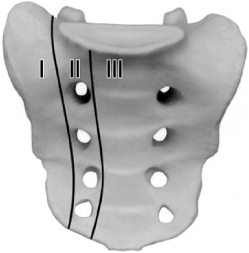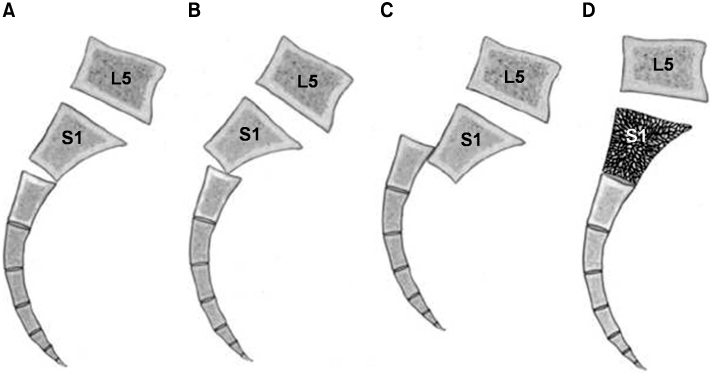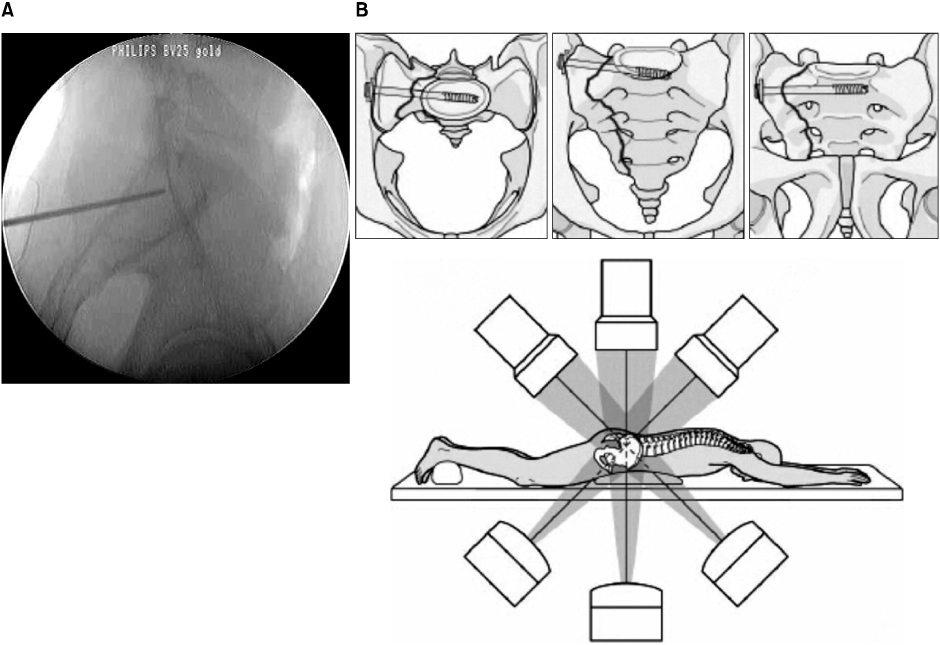J Korean Fract Soc.
2011 Oct;24(4):371-381.
Sacral Fractures
- Affiliations
-
- 1Department of Orthopedic Surgery, Daegu Fatima Hospital, Daegu, Korea. fatimaos@unitel.co.kr
Abstract
- No abstract available.
Figure
Reference
-
1. Albert MJ, Miller ME, MacNaughton M, Hutton WC. 1) Posterior pelvic fixation using a transiliac 4.5-mm reconstruction plate: a clinical and biomechanical study. J Orthop Trauma. 1993. 7:226–232.
Article2. Bents RT, France JC, Glover JM, Kaylor KL. Traumatic spondylopelvic dissociation. A case report and literature review. Spine (Phila Pa 1976). 1996. 21:1814–1819.3. Denis F, Davis S, Comfort T. Sacral fractures: an important problem. Retrospective analysis of 236 cases. Clin Orthop Relat Res. 1988. 227:67–81.4. Ebraheim NA, Coombs R, Hoeflinger MJ, Zeman C, Jackson WT. Anatomical and radiological considerations in compressive bar technique for posterior pelvic disruptions. J Orthop Trauma. 1991. 5:434–438.5. Edeiken-Monroe BS, Browner BD, Jackson H. The role of standard roentgenograms in the evaluation of instability of pelvic ring disruption. Clin Orthop Relat Res. 1989. (240):63–76.
Article6. Failinger MS, McGanity PL. Unstable fractures of the pelvic ring. J Bone Joint Surg Am. 1992. 74:781–791.
Article7. Fountain SS, Hamilton RD, Jameson RM. Transverse fractures of the sacrum. A report of six cases. J Bone Joint Surg Am. 1977. 59:486–489.
Article8. Gibbons KJ, Soloniuk DS, Razack N. Neurological injury and patterns of sacral fractures. J Neurosurg. 1990. 72:889–893.
Article9. Gribnau AJ, van Hensbroek PB, Haverlag R, Ponsen KJ, Been HD, Goslings JC. U-shaped sacral and quality of life. Injury. 2009. 40:1040–1048.10. Hunt N, Jennings A, Smith M. Current management of U-shaped sacral fractures or spino-pelvic dissociation. Injury. 2002. 33:123–126.
Article11. Jackson H, Kam J, Harris JH Jr, Harle TS. The sacral arcuate lines in upper sacral fractures. Radiology. 1982. 145:35–39.
Article12. Kellam JF, McMurtry RY, Paley D, Tile M. The unstable pelvic fracture. Operative treatment. Orthop Clin North Am. 1987. 18:25–41.13. Kim MY, Reidy DP, Nolan PC, Finkelstein JA. Transverse sacral fractures: case series and literature review. Can J Surg. 2001. 44:359–363.14. Krappinger D, Larndorfer R, Struve P, Rosenberger R, Arora R, Blauth M. Minimally invasive transiliac plate osteosynthesis for type C injuries of the pelvic ring: a clinical and radiological follow-up. J Orthop Trauma. 2007. 21:595–602.
Article15. Matta JM, Saucedo T. Internal fixation of pelvic ring fractures. Clin Orthop Relat Res. 1989. (242):83–97.
Article16. Mehta S, Auerbach JD, Born CT, Chin KR. Sacral fractures. J Am Acad Orthop Surg. 2006. 14:656–665.
Article17. Mosheiff R, Liebergall M. Maneuvering the retrograde medullary screw in pubic ramus fractures. J Orthop Trauma. 2002. 16:594–596.
Article18. Nork SE, Jones CB, Harding SP, Mirza SK, Routt ML Jr. Percutaneous stabilization of U-shaped sacral fractures using iliosacral screws: technique and early results. J Orthop Trauma. 2001. 15:238–246.
Article19. Osterhoff G, Ossendorf C, Wanner GA, Simmen HP, Werner CM. Posterior screw fixation in rotationally unstable pelvic ring injuries. Injury. 2011. 42:992–996.
Article20. Pohlemann T, Angst M, Schneider E, Ganz R, Tscherne H. Fixation of transforaminal sacrum fractures: a biomechanical study. J Orthop Trauma. 1993. 7:107–117.21. Riemer BL, Butterfield SL, Diamond DL, et al. Acute mortality associated with injuries to the pelvic ring: the role of early patient mobilization and external fixation. J Trauma. 1993. 35:671–675.22. Robles LA. Transverse sacral fractures. Spine J. 2009. 9:60–69.
Article23. Rommens PM, Hessmann MH. Staged reconstruction of pelvic ring disruption: differences in morbidity, mortality, radiologic results, and functional outcomes between B1, B2/B3, and C-type lesions. J Orthop Trauma. 2002. 16:92–98.
Article24. Rommens PM, Vanderschot PM, Broos PL. Conventional radiography and CT examination of pelvic ring fractures. A comparative study of 90 patients. Unfallchirurg. 1992. 95:387–392.25. Routt MLC Jr, Meier MC, Kregor PJ, et al. Percutaneous iliosacral screws with the patient supine. Oper Tech Orthop. 1993. 7:35–45.26. Routt MLC Jr, Simonian PT, Grujic L. The retrograde medullary superior pubic ramus screw for the treatment of anterior pelvic ring disruptions: a new technique. J Orthop Trauma. 1995. 9:35–44.
Article27. Routt MLC Jr, Simonian PT, Mills WJ. Iliosacral screw fixation: early complications of the percutaneous technique. J Orthop Trauma. 1997. 11:584–589.
Article28. Routt MLC Jr, Simonian PT, Swiontkowski MF. Stabilization of pelvic ring disruptions. Orthop Clin North Am. 1997. 28:369–388.
Article29. Roy-Camille R, Saillant G, Gagna G, Mazel C. Transverse fracture of the upper sacrum. Suicidal jumper's fracture. Spine (Phila Pa 1976). 1985. 10:838–845.30. Sagi HC. Technical aspects and recommended treatment algorithms in triangular osteosynthesis and spinopelvic fixation for vertical shear transforaminal sacral fractures. J Orthop Trauma. 2009. 23:354–360.
Article31. Sagi HC, Militano U, Caron T, Lindvall E. A comprehensive analysis with minimum 1-year follow-up of vertically unstable transforaminal sacral fractures treated with triangular osteosynthesis. J Orthop Trauma. 2009. 23:313–319.
Article32. Schildhauer TA, Bellabarba C, Nork SE, Barei DP, Routt ML Jr, Chapman JR. Decompression and lumbopelvic fixation for sacral fracture-dislocations with spino-pelvic dissociation. J Orthop Trauma. 2006. 20:447–457.
Article33. Schildhauer TA, Josten C, Muhr G. Triangular osteosynthesis of vertically unstable sacrum fractures: a new concept allowing early weight-bearing. J Orthop Trauma. 1998. 12:307–314.
Article34. Schildhauer TA, Ledoux WR, Chapman JR, Henley MB, Tencer AF, Routt ML Jr. Triangular osteosynthesis and iliosacral screw fixation for unstable sacral fractures: a cadaveric and biomechanical evaluation under cyclic loads. J Orthop Trauma. 2003. 17:22–31.
Article35. Schmidek HH, Smith DA, Kristiansen TK. Sacral fractures. Neurosurgery. 1984. 15:735–746.
Article36. Shaw JA, Mino DE, Werner FW, Murray DG. Posterior stabilization of pelvic fractures by use of threaded compression rods. Case reports and mechanical testing. Clin Orthop Relat Res. 1985. (192):240–254.37. Siebler JC, Hasley BP, Mormino MA. Functional outcomes of Denis zone III sacral fractures treated nonoperatively. J Orthop Trauma. 2010. 24:297–302.
Article38. Simonian PT, Routt ML Jr. Biomechanics of pelvic fixation. Orthop Clin North Am. 1997. 28:351–367.
Article39. Starr AJ, Malekzadeh AS. Bucholz RW, Heckman JD, Court-Brown C, editors. Fractures of the pelvic ring. Rockwood and Green's Fractures in adults. 2006. 6th ed. Philadelphia: Lippincott Williams & Wilkins;1585–1664.40. Stocks GW, Gabel GT, Noble PC, Hanson GW, Tullos HS. Anterior and posterior internal fixation of vertical shear fractures of the pelvis. J Orthop Res. 1991. 9:237–245.
Article41. Strange-Vognsen HH, Lebech A. An unusual type of fracture in the upper sacrum. J Orthop Trauma. 1991. 5:200–203.
Article42. Suzuki T, Hak DJ, Ziran BH, et al. Outcome and complications of posterior transiliac plating for vertically unstable sacral fractures. Injury. 2009. 40:405–409.
Article43. Tile M, Helfet DL, Kellam JF. Fractures of the pelvis and acetabulum. 2003. 3rd ed. Philadelphia, USA: Lippincott Williams and Wilkins;203–322.44. Vaccaro AR, Kim DH, Brodke DS, et al. Diagnosis and management of sacral spine fractures. Instr Course Lect. 2004. 53:375–385.
Article45. Vresilovic EJ, Mehta S, Placide R, Milam RA 4th. Traumatic spondylopelvic dissociation. A report of two cases. J Bone Joint Surg Am. 2005. 87:1098–1103.46. Ward EF, Tomasin J, Vander Griend RA. Open reduction and internal fixation of vertical shear pelvic fractures. J Trauma. 1987. 27:291–295.
Article47. White JH, Hague C, Nicolaou S, Gee R, Marchinkow LO, Munk PL. Imaging of sacral fractures. Clin Radiol. 2003. 58:914–921.
Article48. Yi C, Hak DJ. Traumatic spinopelvic dissociation or U-shaped sacral fracture: a review of the literature. Injury. 2011. In press.
Article
- Full Text Links
- Actions
-
Cited
- CITED
-
- Close
- Share
- Similar articles
-
- Lumbo-sacro-pelvic Fixation Using Iliac Screws for the Complex Lumbo-sacral Fractures
- Sequential Sacral Insufficiency Fracture After Unilateral Pubic Fractures: A Case Report
- A Case of S1 Radiculopathy in Sacral Insufficiency Fracture without Fracture Line
- MR Findings of Sacral Insufficiency Fractures in Osteoporotic Patients: Two Cases Report
- Spino-Pelvic Fixation in Unstable Sacral Fracture: A Case Report









